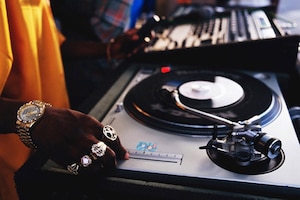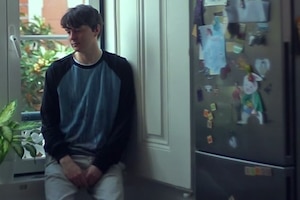Best Music Journalism: January 2015
We’re music nerds at Red Bull Music Academy, but we’re also music journalism nerds. Each month, we point you to some of the best things we’ve read. This time around Lauren Martin highlights an eye-opening chat with Björk, an unpublished Elliott Smith interview, and more.
Wheel It Up: History of the Rewind (Laurent Fintoni, Cuepoint)

In this absorbing, thorough investigation by frequent RBMA contributor Laurent Fintoni, the story of pulling back records on a soundsystem is detailed with care. Travelling from Jamaica to the US and the UK, from the late ’60s to the present day, Fintoni dips in and out of musical genres, character anecdotes and personal insight to see how the humble rewind has come to be seen as a simple, elegant, democratic element of dance music culture.
Interviews: Elliott Smith (Blank On Blank)

Not strictly music writing, per se, but as Piotr Orlov noted in the Best Music Journalism of 2014 round-up, “The definition of music journalism is more unsettled than ever. Is it always written – or could it be video? Is it exclusively factual and reported – or could it be first-person criticism with a sprinkling of fiction?” The relatively new Blank On Blank series appears to touch on nearly all aspects of this. A YouTube series with a dedicated website, Blank On Blank positions itself as a playful, sincere way to present old recorded interviews with artists from a variety of musical genres; by illustrating them with animations to bring the voices and stories to life. January’s effort with Elliott Smith is particularly good: for a figure whose cult following is so focused on voice and lyricism, there’s a touching cadence to hearing Smith open up as he does.
The Invisible Woman: A Conversation with Björk (Jessica Hopper, Pitchfork)
If one thing strikes you about this excellent interview with Björk, it’s that editors should send more women to interview more women about being a woman – the results could be as rewarding as this Pitchfork feature by Jessica Hopper. Focusing on the emotional and physical chaos that follows the breakdown of a long-term relationship, and touching on motherhood, sexism in the music industry, insecurities and myriad other “hold your breath” insights, Björk once again shows how vital, fascinating and talented an artist she really is.
Feminine Appropriation Was 2014’s Biggest Electronic Music Trend (Steph Kretowicz, The FADER)

Although strictly posted on New Years Eve, this opinion piece by Steph Kretowicz for The FADER is entirely necessary for the conversation around gender in electronic music in 2015. Honing in on the oft-discussed aesthetics of UK production crew PC Music, Kretowicz considers the self-conscious styling of male artists with “feminine” traits a la SOPHIE. In a world where dance music has become a global, billion-dollar industry but women are sorely underrepresented, the underground still needs to look at itself when it comes to gender issues. Or, in her own words, “Perhaps it’s time the boys owned up to the fact that they’re taking all the girly shit without taking the shit for being girls.”
Salon Des Amateurs: The post-kraut Haçienda (Aaron Coultate, Resident Advisor)

Resident Advisor continue their typically strong editorial writing with this report by Aaron Coultate on Düsseldorf’s Salon Des Amateurs. With the older and younger generation of the Salon interviewed, Detlef Weinrich and Jan Schulte respectively, as well as covering various resident DJs, guests, regulars and, of course, the bar itself, this is a deftly pulled together look at what a small space with a regular audience can do.
The Wanderer: A Conversation With Panda Bear (Philip Sherburne, Pitchfork)

Another entry from Pitchfork this month, but with such a personal, involving read as this, it was hard to choose between this and Hopper’s Bjork feature. Travelling to Lisbon, writer Philip Sherburne is invited into the home of Noah Lennox of Animal Collective to explore his solo project, Panda Bear, and how life in the Portuguese capital has gradually folded into his acclaimed sound. It’s an endearing, tactile account of a musician and his home life, told with zest.

